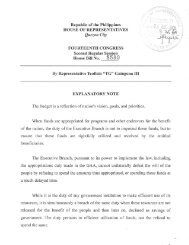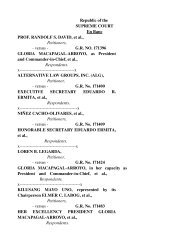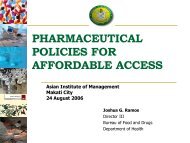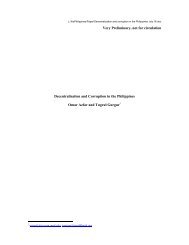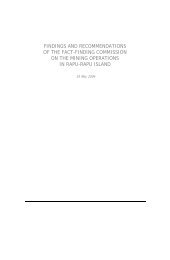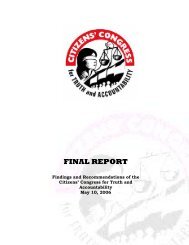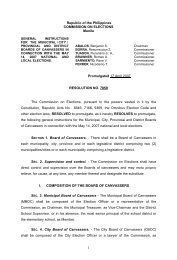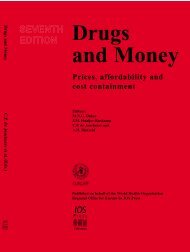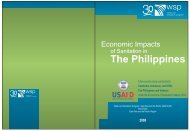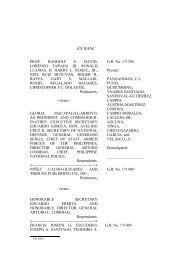The state of water resources in the Philippines - Greenpeace
The state of water resources in the Philippines - Greenpeace
The state of water resources in the Philippines - Greenpeace
Create successful ePaper yourself
Turn your PDF publications into a flip-book with our unique Google optimized e-Paper software.
permit to operate (PTO), <strong>the</strong> practice <strong>of</strong> unannounced visits, and <strong>the</strong> resistance<br />
<strong>of</strong> firms to <strong>in</strong>spection and o<strong>the</strong>r regulatory processes.”<br />
This report also presents <strong>in</strong>sights regard<strong>in</strong>g <strong>in</strong>dicators used by DENR to evaluate<br />
program success.<br />
Accord<strong>in</strong>g to <strong>the</strong> report, each year, DENR sets targets to be achieved with<strong>in</strong> <strong>the</strong><br />
year, and are assessed at <strong>the</strong> end <strong>of</strong> each year. Oftentimes, unit reports would<br />
show that achievements are ei<strong>the</strong>r close to or even exceed <strong>the</strong> targets.<br />
However, scientific studies cont<strong>in</strong>ue to show <strong>the</strong> worsen<strong>in</strong>g pollution problem <strong>in</strong><br />
<strong>the</strong> country, which, accord<strong>in</strong>g to <strong>the</strong> report, suggests that <strong>the</strong> data <strong>the</strong> agency is<br />
ga<strong>the</strong>r<strong>in</strong>g are not <strong>the</strong> appropriate <strong>in</strong>dicators for efficiency and success.<br />
<strong>The</strong> report <strong>the</strong>n compares DENR’s practice with program evaluation conducted<br />
by <strong>the</strong> LLDA. <strong>The</strong> report observes that <strong>the</strong> experience <strong>of</strong> LLDA where studies<br />
before and after <strong>the</strong> imposition <strong>of</strong> <strong>the</strong> regulation clearly <strong>in</strong>dicate that <strong>the</strong>re were<br />
quantitative (amount <strong>of</strong> waste<strong>water</strong> discharged by companies) and qualitative<br />
(changes <strong>in</strong> process<strong>in</strong>g technology <strong>in</strong>itiated) impacts <strong>of</strong> <strong>the</strong> regulation that lead to<br />
a decrease <strong>in</strong> effluent discharges.<br />
While <strong>the</strong>re is a need to address limitations on exist<strong>in</strong>g standards for <strong>water</strong><br />
quality and effluents to ensure that all types <strong>of</strong> pollutants are taken <strong>in</strong>to<br />
consideration, enforcement issues seem to be ano<strong>the</strong>r big issue that is greatly<br />
<strong>in</strong>fluenced by <strong>in</strong>stitutional concerns ra<strong>the</strong>r than <strong>the</strong> absence or limitation <strong>of</strong><br />
exist<strong>in</strong>g policies. It seems clear that what is called for are pollution preventionoriented<br />
policies ra<strong>the</strong>r than mere regulations which, although present and, on<br />
paper, presumably adequate, prove to be very difficult for <strong>in</strong>volved government<br />
agencies to enforce.<br />
V. Status <strong>of</strong> clean production <strong>in</strong> <strong>the</strong> Philipp<strong>in</strong>es<br />
Clean Production is a whole new way <strong>of</strong> look<strong>in</strong>g at how products are produced<br />
and consumed. More than just good housekeep<strong>in</strong>g and pollution prevention <strong>in</strong><br />
factories, it is about redesign<strong>in</strong>g products and product systems so that <strong>the</strong>y are<br />
more attuned to natural processes throughout <strong>the</strong> product’s entire life cycle.<br />
Clean Production is based on <strong>the</strong> Precautionary Pr<strong>in</strong>ciple (when an activity has<br />
<strong>the</strong> potential to harm human health or <strong>the</strong> environment, a cautious approach<br />
should be taken <strong>in</strong> advance—even if <strong>the</strong> full extent <strong>of</strong> harm has not yet been fully<br />
established scientifically) and follows product life cycles rooted <strong>in</strong> circular<br />
concepts, not l<strong>in</strong>ear as is <strong>the</strong> conventional production system. It also promotes<br />
<strong>the</strong> use <strong>of</strong> renewable energy, m<strong>in</strong>imal resource <strong>in</strong>puts that are non-toxic <strong>in</strong> a<br />
closed loop and susta<strong>in</strong>able system, and generates wastes that are benign and<br />
returnable <strong>in</strong>to <strong>the</strong> production process. Fur<strong>the</strong>rmore, it promotes <strong>the</strong> protection <strong>of</strong><br />
biological and cultural diversity. F<strong>in</strong>ally Clean Production must encourage<br />
democratic processes especially among affected sectors.<br />
Global companies with operations <strong>in</strong> <strong>the</strong> Philipp<strong>in</strong>es have started to set targets<br />
and timel<strong>in</strong>es for phase out <strong>of</strong> some <strong>of</strong> <strong>the</strong> most toxic chemicals <strong>in</strong> <strong>the</strong>ir products<br />
and product systems. Nokia, for example, has already elim<strong>in</strong>ated Polyv<strong>in</strong>yl<br />
GREENPEACE | <strong>The</strong> <strong>state</strong> <strong>of</strong> <strong>water</strong> <strong>in</strong> <strong>the</strong> Philipp<strong>in</strong>es 42



